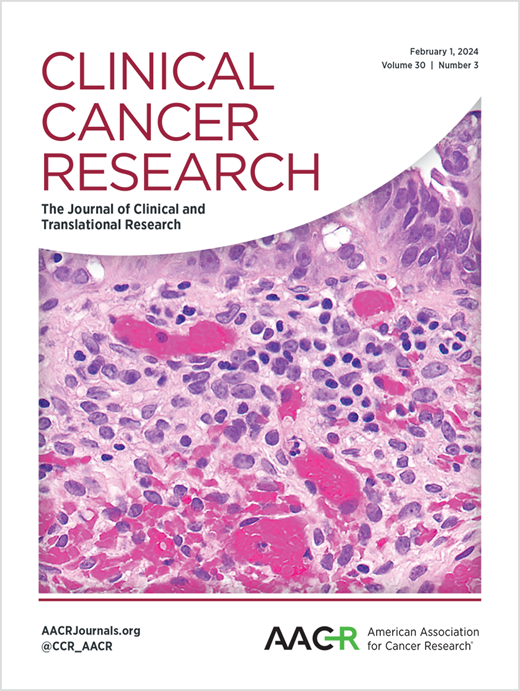BET溴域抑制通过诱导miR-34a-5p逆转雌激素受体阳性乳腺癌中CDK4/6抑制剂的耐药性。
IF 10.2
1区 医学
Q1 ONCOLOGY
引用次数: 0
摘要
目的:dk6过表达是获得性CDK4/6抑制剂耐药的关键决定因素之一。由于BRD4被募集到CDK6启动子上,我们研究了溴域和外端结构域(BET)抑制逆转CDK4/6抑制剂耐药性的潜力。实验设计:采用细胞活力和存活测定以及细胞系异种移植来评估抗palbociclib乳腺癌细胞对BET的抑制作用。用载体和BET抑制剂处理的细胞进行RNA测序。利用荧光素酶法评估CDK6启动子活性,并使用miRPathDB V2.0数据库鉴定介导BET抑制作用的潜在mirna。通过实验来确定持续的帕博西尼治疗是否对BET抑制剂的疗效至关重要,并探索相关机制。结果在过表达CDK6的CDK4/6抑制剂耐药模型中,BET抑制后细胞周期基因特征差异下调。BET抑制剂JQ1和ZEN-3694降低了CDK6和cyclin D1的表达,恢复了CDK4/6抑制剂诱导的细胞周期阻滞,并在体外引发细胞凋亡和体内肿瘤消退。在机制上,BET抑制通过诱导miR-34a-5p下调CDK6表达,而不是直接抑制CDK6启动子。引入miR-34a-5p抑制剂消除了BET抑制剂介导的分子变化,而miR-34a-5p模拟物复制了BET抑制的效果。最后,耐药细胞在持续使用帕博西尼的情况下表现出BCL-2的下调,与ER表达降低相关,促进了对BET抑制的敏感性。我们的研究结果强调,在ER+乳腺癌亚群中,抑制BET或应用miR-34a-5p模拟物是逆转CDK4/6抑制剂耐药的有希望的策略。本文章由计算机程序翻译,如有差异,请以英文原文为准。
BET bromodomain inhibition reverses CDK4/6 inhibitor resistance in estrogen receptor-positive breast cancer via induction of miR-34a-5p.
PURPOSE
CDK6 overexpression is one critical determinant of acquired CDK4/6 inhibitor resistance. Because BRD4 is recruited to the CDK6 promoter, we investigated the potential of bromodomain and extra-terminal domain (BET) inhibition to reverse CDK4/6 inhibitor resistance.
EXPERIMENTAL DESIGN
Cell viability and survival assays and cell line xenografts were utilized to evaluate BET inhibition in palbociclib-resistant breast cancer cells. Vehicle- and BET inhibitor-treated cells were subjected to RNA sequencing. CDK6 promoter activity was assessed with luciferase assays, and the miRPathDB V2.0 database was used to identify potential miRNAs mediating the effects of BET inhibition. Experiments were conducted to determine whether continued palbociclib treatment is essential for BET inhibitor efficacy and to explore associated mechanisms.
RESULTS
In CDK4/6 inhibitor-resistant models overexpressing CDK6, a cell cycle gene signature was differentially downregulated following BET inhibition. The BET inhibitors JQ1 and ZEN-3694 reduced the expression of CDK6 and cyclin D1, reinstated CDK4/6 inhibitor-induced cell cycle arrest, and triggered apoptosis in vitro, as well as tumor regression in vivo. Mechanistically, BET inhibition downregulated CDK6 expression through the induction of miR-34a-5p, rather than by directly repressing the CDK6 promoter. Introduction of a miR-34a-5p inhibitor abrogated BET inhibitor-mediated molecular changes, whereas a miR-34a-5p mimic replicated the effects of BET inhibition. Lastly, resistant cells exhibited downregulation of BCL-2 in the presence of continued palbociclib, associated with reduced ER⍺ expression, facilitating sensitivity to BET inhibition.
CONCLUSIONS
Our findings highlight BET inhibition or application of miR-34a-5p mimics as promising strategies to reverse CDK4/6 inhibitor resistance in a subset of ER+ breast cancers.
求助全文
通过发布文献求助,成功后即可免费获取论文全文。
去求助
来源期刊

Clinical Cancer Research
医学-肿瘤学
CiteScore
20.10
自引率
1.70%
发文量
1207
审稿时长
2.1 months
期刊介绍:
Clinical Cancer Research is a journal focusing on groundbreaking research in cancer, specifically in the areas where the laboratory and the clinic intersect. Our primary interest lies in clinical trials that investigate novel treatments, accompanied by research on pharmacology, molecular alterations, and biomarkers that can predict response or resistance to these treatments. Furthermore, we prioritize laboratory and animal studies that explore new drugs and targeted agents with the potential to advance to clinical trials. We also encourage research on targetable mechanisms of cancer development, progression, and metastasis.
 求助内容:
求助内容: 应助结果提醒方式:
应助结果提醒方式:


